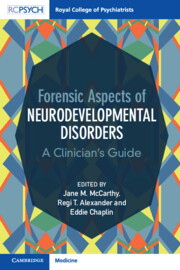Book contents
- Forensic Aspects of Neurodevelopmental Disorders
- Forensic Aspects of Neurodevelopmental Disorders
- Copyright page
- About the Cover Page
- Contents
- Contributors
- Foreword by the Rt Hon Lord Bradley
- Terminology Used in the Book
- Section 1 An Overview: Definitions, Epidemiology and Policy Issues
- Section 2 Assessment and Therapeutic Approach
- Section 3 Criminal Justice Pathways and Legal Issues
- Chapter 16 Criminal Justice Pathways and Neurodevelopmental Disorders
- Chapter 17 The Mental Health Act and Other Relevant Legislation in Relation to Neurodevelopmental Disorders in the UK
- Chapter 18 Fitness to Plead and Neurodevelopmental Disorders
- Chapter 19 Fitness to Plead Procedures in Relation to Mental Health and Capacity Legislation
- Chapter 20 Forensic Services for Neurodevelopmental Disorders: An English Perspective
- Chapter 21 Offenders with Neurodevelopmental Disorders in Four Nordic Countries
- Chapter 22 Forensic Neurodevelopmental Disabilities: A Perspective from Ontario, Canada on Pathways and Services
- Chapter 23 Forensic Aspects of Neurodevelopmental Disorders: An Australasian Perspective
- Chapter 24 Concluding Comments
- Index
- References
Chapter 18 - Fitness to Plead and Neurodevelopmental Disorders
from Section 3 - Criminal Justice Pathways and Legal Issues
Published online by Cambridge University Press: 18 May 2023
- Forensic Aspects of Neurodevelopmental Disorders
- Forensic Aspects of Neurodevelopmental Disorders
- Copyright page
- About the Cover Page
- Contents
- Contributors
- Foreword by the Rt Hon Lord Bradley
- Terminology Used in the Book
- Section 1 An Overview: Definitions, Epidemiology and Policy Issues
- Section 2 Assessment and Therapeutic Approach
- Section 3 Criminal Justice Pathways and Legal Issues
- Chapter 16 Criminal Justice Pathways and Neurodevelopmental Disorders
- Chapter 17 The Mental Health Act and Other Relevant Legislation in Relation to Neurodevelopmental Disorders in the UK
- Chapter 18 Fitness to Plead and Neurodevelopmental Disorders
- Chapter 19 Fitness to Plead Procedures in Relation to Mental Health and Capacity Legislation
- Chapter 20 Forensic Services for Neurodevelopmental Disorders: An English Perspective
- Chapter 21 Offenders with Neurodevelopmental Disorders in Four Nordic Countries
- Chapter 22 Forensic Neurodevelopmental Disabilities: A Perspective from Ontario, Canada on Pathways and Services
- Chapter 23 Forensic Aspects of Neurodevelopmental Disorders: An Australasian Perspective
- Chapter 24 Concluding Comments
- Index
- References
Summary
The right to a fair trial is embedded in human rights law. For a trial to be fair, the accused needs to be an active participant – to understand what they have been charged with and to be able answer that charge in a meaningful way. Laws relating to fitness to plead, or competence to stand trial, have developed in many jurisdictions and are designed to protect vulnerable defendants and in some cases divert them into healthcare. There are concerns that the law is not currently fit for purpose. Defendants with neurodevelopmental disorders face particular challenges when accused of a criminal charge at court. Many present with communication deficits, poor understanding and cognitive impairments, stereotyped and other abnormal behaviours, and lack of theory of mind. Identifying those who are unfit to plead can be problematic. In this chapter, we describe legal frameworks for fitness to plead and consider how neurodevelopmental disorders can impact an individual’s ability to participate effectively in their trial. We consider how best to identify, assess and support vulnerable defendants to improve their experience at court and ensure their fair trial rights are upheld.
Keywords
- Type
- Chapter
- Information
- Forensic Aspects of Neurodevelopmental DisordersA Clinician's Guide, pp. 217 - 233Publisher: Cambridge University PressPrint publication year: 2023



